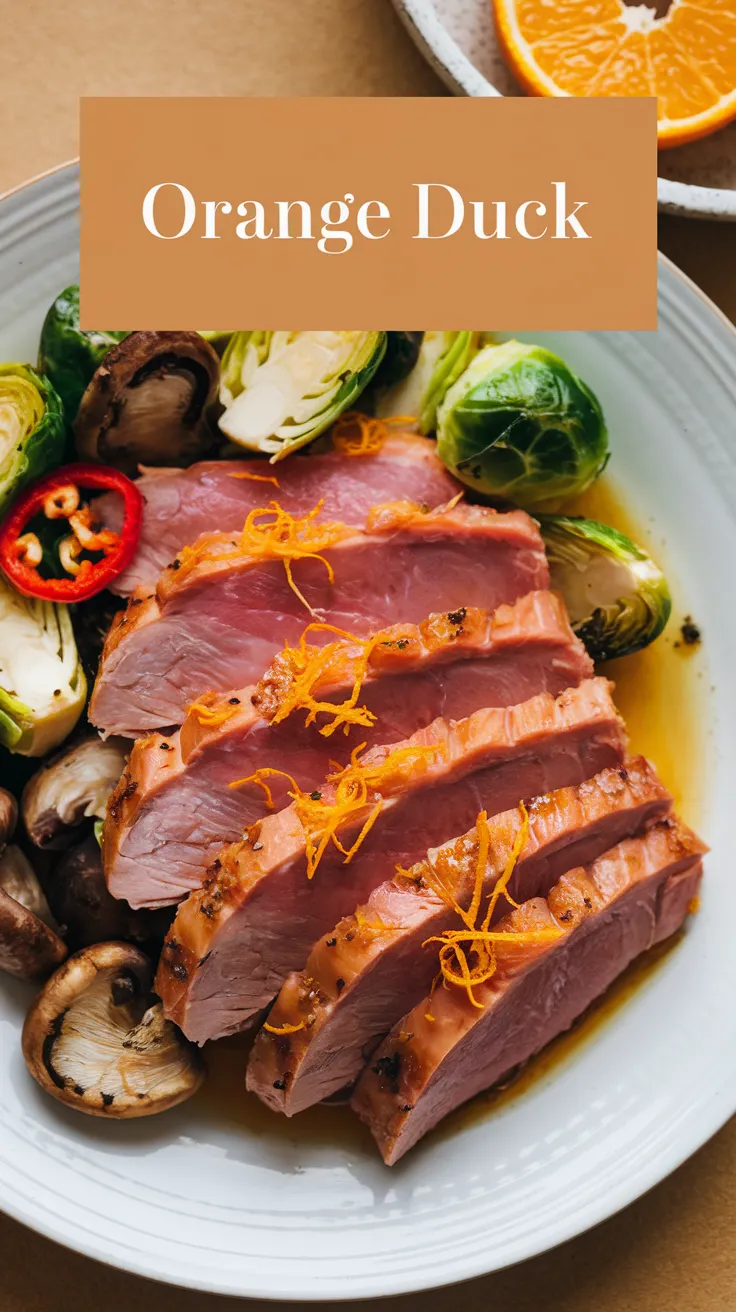Growing up with a love for bold and unique flavors, I’ve always been drawn to dishes that strike the perfect balance between richness and freshness.
This orange duck recipe—often referred to as Duck à l’Orange—is a testament to that harmony.
With its crispy, golden skin and tangy orange sauce, it’s an elegant dish that feels like a gourmet experience, yet it’s surprisingly simple to prepare.
Orange duck is a classic French-inspired dish that combines the tender richness of duck breast with a sweet and tangy orange sauce.
Perfect for dinner parties or a special family meal, this dish is all about balancing the duck’s savory flavors with the bright citrus notes of the sauce.
The result is a show-stopping plate that tastes as incredible as it looks.
Orange Duck
Course: MainCuisine: French-inspiredDifficulty: Intermediate2
servings20
minutes30
minutes450
kcalIngredients
- For the Duck
2 duck breasts (8 ounces each, skin-on)
1 tablespoon kosher salt (or to taste)
½ teaspoon freshly ground black pepper
1 tablespoon duck fat (or vegetable oil)
- For the Orange Sauce:
1 tablespoon fresh orange zest (divided into fine zest and thin strips for garnish)
2 tablespoon Grand Marnier (or another orange liqueur)
2 tablespoon cherry vinegar (or red wine vinegar)
2 tablespoon orange marmalade
1 pinch cayenne pepper
1 cup chicken stock (or duck stock, if available)
1 teaspoon all-purpose flour
1 tablespoon unsalted butter
Directions
- Prepare the Duck:
- Score the Skin: Using a sharp knife, score the skin of each duck breast in a cross-hatch pattern, being careful not to cut into the meat.
- Season: Generously salt the skin and meat sides of the duck breasts. Let them rest at room temperature for 15 minutes to draw out moisture from the skin.
- Pat Dry: After resting, pat the duck breasts dry with paper towels and lightly re-season the skin with a touch of salt.
- Cook the Duck:
- Heat a heavy-duty skillet over medium heat. Add duck fat or vegetable oil and heat for about 2 minutes.
- Place the duck breasts skin-side down in the skillet. Cook for 6 minutes, allowing the fat to render out and the skin to become crispy. Adjust the heat slightly if needed to maintain a steady sizzle.
- Flip the duck breasts and cook for an additional 4 minutes to achieve medium doneness (pink and juicy in the center). Use the poke test or thermometer (target internal temperature: ~135°F/57°C for medium).
- Remove the duck breasts from the skillet and let them rest on a plate for at least 10 minutes.
- Prepare the Sauce:
- Discard most of the rendered duck fat from the skillet, leaving behind a thin layer.
- Add 1 teaspoon of flour to the skillet and stir it into the remaining fat over medium heat. Cook for 1 minute to remove the raw flavor.
- Add the orange zest, Grand Marnier, cherry vinegar, orange marmalade, cayenne pepper, and chicken stock. Stir well to deglaze the pan and dissolve caramelized bits into the sauce.
- Bring the mixture to a boil, then reduce to a simmer. Let the sauce reduce until it thickens slightly and coats the back of a spoon (~5–7 minutes).
- Remove from heat and whisk in the butter until the sauce becomes glossy. Taste and adjust salt if necessary.
- Serve:
- Slice the duck breasts crosswise into thin slices. Arrange on a serving plate and drizzle generously with the orange sauce.
- Garnish with thin strips of orange zest for an elegant finish.
Recipe Video
Notes
- Duck Fat: Save any rendered duck fat—it’s fantastic for roasting vegetables or making the crispiest potatoes.
- Vinegar Substitute: If cherry vinegar isn’t available, red wine vinegar or apple cider vinegar works well.
- Doneness Preference: For those who prefer well-done duck, extend cooking time by 2–3 minutes per side.
Storage and Warming Leftovers
Storage: Store leftovers in an airtight container in the refrigerator for up to 3 days.
Reheating: Reheat slices gently in a skillet over low heat to preserve the crispy skin. Avoid microwaving, as it can make the skin soggy.

